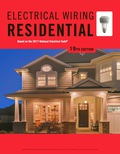
EBK ELECTRICAL WIRING RESIDENTIAL
19th Edition
ISBN: 9781337516549
Author: Simmons
Publisher: CENGAGE LEARNING - CONSIGNMENT
expand_more
expand_more
format_list_bulleted
Textbook Question
Chapter 23.1, Problem 17R
Electric heating cable embedded in plaster, or sandwiched between layers of dry wall, creates heat. Therefore, any nonmetallic-sheathed cable run above these ceilings and buried in insulation must have its current-carrying capacity derated according to the (40°C) (50°C) (60°C) correction factors found in Table 310.15(B)(2)(a) in the NEC. (Circle the correct answer.)
Expert Solution & Answer
Trending nowThis is a popular solution!

Students have asked these similar questions
At t = 0, the switch closes. Find the IL(t) and VL(t) for t≥ 0 in t and s domain.
Can you help me?
1)
(+.
24V
ง
Anahtar t=0 anında kapatılıyor.
to icin TL(t) ve
bulunuz.
J
3√√√2
ww
مفروم
+
t=0
$6.5 5H VLCH) 2.2
Vilt)
"For the network in the figure, determine RE and RB if A₁
Zb = BRE."
=
-10 and re
=
3.8. Assume that
2.a. Simplify and determine Zk+ for:
2.x. 60 [Hz]
⚫ 2.y. 180 [Hz]
a.x.
60[Hz]
a.y. 180 [Hz]
Joo
(127
2[H]
w
240
[√]
Chapter 23 Solutions
EBK ELECTRICAL WIRING RESIDENTIAL
Ch. 23.1 - a. What is the allowance in watts made for...Ch. 23.1 - What are some of the advantages of electric...Ch. 23.1 - List the different types of electric heating...Ch. 23.1 - There are two basic voltage classifications for...Ch. 23.1 - What device is required when the total connected...Ch. 23.1 - Prob. 6RCh. 23.1 - Prob. 7RCh. 23.1 - A certain type of control connects electric...Ch. 23.1 - What advantages does a 240-volt heating unit have...Ch. 23.1 - The white wire of a cable may be used to connect...
Ch. 23.1 - Receptacle outlets furnished as part of a...Ch. 23.1 - The branch circuit supplying a fixed electric...Ch. 23.1 - Prob. 13RCh. 23.1 - For ballpark calculations, the wattage output of a...Ch. 23.1 - A central electric furnace heating system is...Ch. 23.1 - What section of the Code provides the correct...Ch. 23.1 - Electric heating cable embedded in plaster, or...Ch. 23.2 - Prob. 1RCh. 23.2 - Prob. 2RCh. 23.2 - Prob. 3RCh. 23.2 - a. Must an air conditioner installed in a window...Ch. 23.2 - Prob. 5RCh. 23.2 - What is the Code requirement for receptacles...Ch. 23.2 - Prob. 7RCh. 23.2 - When the nameplate on an air-conditioning unit...Ch. 23.2 - Prob. 9RCh. 23.2 - Match the following terms with the statement that...Ch. 23.2 - The disconnect for an air conditioner or heat pump...
Knowledge Booster
Learn more about
Need a deep-dive on the concept behind this application? Look no further. Learn more about this topic, electrical-engineering and related others by exploring similar questions and additional content below.Similar questions
- P3. Given the following network, determine: ⚫ 3.a. Equivalent Y ⚫ 3.b. Equivalent A 2 R[2] 10 8 b 20 30 5arrow_forward[Electrical Circuits] P1. Using the mesh current method, calculate the magnitude and direction of: 1.a. I and I (mesh currents) 1.b. I10 (test current in R10 = 1082) 1.c. (Calculate the magnitude and signs of V10) 6[A] 12 [√] بي 10 38 20 4A] Iw -800arrow_forwardNeed handwritten solution do not use chatgptarrow_forward
- [07/01, 16:59] C P: Question: Calculate the following for 100Hz and 500Hz (express all answers in phasor form). Show all work. A) Xc and ZTB) VR1 and VC1 C) IT Handwritten Solution Pleasearrow_forward1. Sketch the root loci of a system with the following characteristic equation: s²+2s+2+K(s+2)=0 2. Sketch the root loci for the following loop transfer function: KG(s)H(s)=- K(s+1) s(s+2)(s²+2s+4)arrow_forward3. For the unity feedback system with forward path transfer function, G(s), below: G(s)= K(s² +8) (s+4)(s+5) Sketch the root locus and show the breakaway/break-in point(s) and jo-axis crossing. Determine the angle of arrival and K value at the breakaway/break- in point(s). Give your comment the system is stable or unstable.arrow_forward
- Find the step response of each of the transfer functions shown in Eqs. (4.62) through (4.64) and compare them. [Shown in the image]Book: Norman S. Nise - Control Systems Engineering, 6th EditionTopic: Chapter-4: Time Response, Example 4.8Solve the math with proper explanation. Please don't give AI response. Asking for a expert verified answer.arrow_forward2. With respect to the circuit shown in Figure 2 below V2 -R1 R2 R4 w R3 R5 Figure 2: DC Circuit 2 a. Using Ohm's and Kirchhoff's laws calculate the current flowing through R3 and so determine wattage rating of R3. b. Verify your results with simulations. Note: you must use the values for the components in Table 2. Table 2 V2 (Volts) R1 (KQ) R2 (KQ) R3 (KQ) R4 (KQ) R5 (KQ) 9 3.3 5 10 6 1 3.3arrow_forwardDon't use ai to answer i will report your answerarrow_forward
- Don't use ai to answer I will report you answerarrow_forwardcircuit value of i1 and i2arrow_forwardIn the circuit shown in the figure, the switch opens at time t = 0. For t≥ 0 use I(t) and V₁(t) or Find Vc(t) and lc(t). D to icht) w 43 ViLC+) + vc(+) 5. F + 1252 18 A 3) 2H2VLCH 8 V 4л warrow_forward
arrow_back_ios
SEE MORE QUESTIONS
arrow_forward_ios
Recommended textbooks for you
 EBK ELECTRICAL WIRING RESIDENTIALElectrical EngineeringISBN:9781337516549Author:SimmonsPublisher:CENGAGE LEARNING - CONSIGNMENT
EBK ELECTRICAL WIRING RESIDENTIALElectrical EngineeringISBN:9781337516549Author:SimmonsPublisher:CENGAGE LEARNING - CONSIGNMENT

EBK ELECTRICAL WIRING RESIDENTIAL
Electrical Engineering
ISBN:9781337516549
Author:Simmons
Publisher:CENGAGE LEARNING - CONSIGNMENT
Introduction to 8051 Microcontroller | Part 1 | Bharat Acharya Education; Author: Bharat Acharya Education;https://www.youtube.com/watch?v=2-geyR_aM28;License: Standard Youtube License